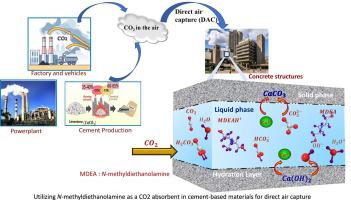Chemical Engineering Journal ( IF 13.3 ) Pub Date : 2023-09-18 , DOI: 10.1016/j.cej.2023.146067 Kirushnapillai Kopitha , Yogarajah Elakneswaran , Ryoma Kitagaki , Ryosuke Saito , Masato Tsujino , Akira Nishida , Hisanori Senboku , Naoki Hiroyoshi

|
The escalating release of CO2 into the atmosphere has turned the matter of global warming into a pressing issue. Therefore, direct air capture (DAC - capturing CO2 from the environment) using buildings and infrastructure made of cement-based materials as “synthetic trees” could be an effective approach, given the growing urbanization trend. This study proposed a new technique to use N-methyldiethanolamine (MDEA) in cement-based materials to sequestrate CO2 from the environment. It has significant potential and flexibility compared to existing CO2 capture technologies, particularly given the limitations of CO2 mineralization in cement-based materials with slow kinetics. Furthermore, this study examined the resulting microstructural changes and reaction mechanisms of each hydrated phase, such as Ca(OH)2, calcium-silicate-hydrate (C-S-H), and hydrated cement, due to the addition of MDEA after carbonation. The study also investigated the effect of different percentages of amine on the carbonation of Ca(OH)2 under accelerated conditions, followed by the natural carbonation of cement paste coarse particles. The results showed that a 10% MDEA of water volume is optimal for CO2 capture in cement-based materials. Beyond this percentage, MDEA loss on the surface of solid particles was observed by thermogravimetric analysis (TGA). The study also examined the changes in microstructure, chemical environment, pH, and calcite formation in the cement paste samples with one side exposed to accelerated carbonation. MDEA increased calcite formation by 1.5–2 times compared to the samples that did not contain MDEA. Additionally, aragonite and calcite were formed when MDEA was present, whereas the samples without MDEA only formed calcite.
中文翻译:

N-甲基二乙醇胺 (MDEA) 作为一种有效的二氧化碳吸收剂,用于水泥基材料中的直接空气捕获 (DAC)
CO 2不断增加地释放到大气中已经使全球变暖问题成为一个紧迫的问题。因此,鉴于日益增长的城市化趋势,使用水泥基材料制成的建筑物和基础设施作为“合成树”进行直接空气捕获(DAC - 从环境中捕获CO 2 )可能是一种有效的方法。本研究提出了一种在水泥基材料中使用N-甲基二乙醇胺(MDEA)来封存环境中CO 2的新技术。与现有的 CO 2捕集技术相比,它具有巨大的潜力和灵活性,特别是考虑到 CO 2的局限性水泥基材料中的矿化具有缓慢的动力学。此外,本研究还研究了由于碳酸化后添加 MDEA 而导致各水合相(例如 Ca(OH) 2、水合硅酸钙 (CSH) 和水合水泥)的微观结构变化和反应机制。该研究还研究了不同比例的胺对加速条件下Ca(OH) 2碳化的影响,以及水泥浆粗颗粒自然碳化的影响。结果表明,水体积的 10% MDEA 对于 CO 2是最佳的水泥基材料中的捕获。超过这个百分比,通过热重分析 (TGA) 观察到固体颗粒表面的 MDEA 损失。该研究还研究了一侧暴露于加速碳化的水泥浆样品的微观结构、化学环境、pH 值和方解石形成的变化。与不含 MDEA 的样品相比,MDEA 使方解石的形成增加了 1.5-2 倍。此外,当存在 MDEA 时,形成霰石和方解石,而不含 MDEA 的样品仅形成方解石。






























 京公网安备 11010802027423号
京公网安备 11010802027423号